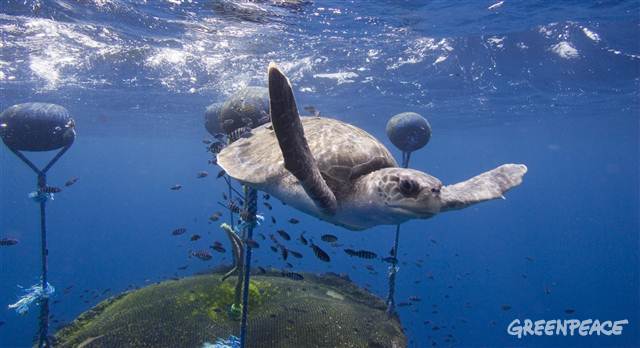Greenpeace has long been concerned about the bycatch caused by the use of Fish Aggregating Devices, or FADs, with purse seine nets. This fishing method is a deadly combination of a floating object, left adrift for weeks or months, and a huge encircling net that takes everything in the vicinity.

Original Blog post by Karli Thomas
It’s a devastating fishing method, but it’s being used to catch tuna for companies like John West Australia (you might have seen our parody of their new TV advert).
FADs are deployed in huge numbers across our oceans, and float about in their passive-aggressive way. They lure in not just tuna but sharks, dolphin fish, billfish, rainbow runners, triggerfish, baby tuna, turtles – and many more of Nemo’s buddies. Then comes the ‘encircling net’ part… and let’s just say it doesn’t end well for most of these underwater characters. FAD fishing is no Disney movie with “happily ever after” to look forward to.
Author Charles Clover described it well when he wrote: “Killed alongside the skipjack tuna that finds itself in your tin is almost the entire cast list of Finding Nemo.” Whistle-blowers in the fishing industry itself have released footage and shared their concerns about the impacts of purse seine fishing on FADs.
For too long, heavyweights in the tuna industry have downplayed the impact of FADs, though their own data reveals that the bycatch of baby tuna and other ocean life is many times higher when FADs are used (for example, FAD catches may comprise 15-20% undersized tuna, and the non-tuna bycatch is five to ten times higher with FADs than in free-school fishing).
The industry group the International Sustainable Seafood Foundation, ISSF, claims that FADs could reduce the carbon footprint of tuna fishing, but their data doesn’t pan out on that front either: When purse seiners use FADs more, they tend to use more fuel too.
But last week, the ISSF acknowledged that there’s a very real problem with creatures becoming entangled in FADs. Images in their latest publication show creatures like turtles and sharks trapped in the netting that is often part of a FAD’s structure. ISSF also reveals the alarming fact from the Eastern Pacific: “around 1% of FADs that are set on by purse seiners have turtles entangled”.
While 1% may seem like a low figure, and although some of those turtles may still be alive and can be released when the fishing vessel returns – that is definitely a cause for concern. Bear in mind that there are hundreds of purse seiners out there, each with many FADs deployed at any given time. The Eastern Pacific has also been identified as a “high risk, high threat” area for two critically endangered turtles, the leatherback and the hawksbill. Needless to say, for critically endangered species, every turtle counts.
Of course, the fishing industry and its representatives are so wedded to the idea of fishing with FADs that they want to solve just a bit of the problem (the sharks, turtles and other things that are clearly not tuna) and then carry on, more or less ‘business as usual’, with a slightly different model of FAD – but still a massive problem with bycatch of baby tuna.
It’s not good enough.
Scientific advice is clear, the baby bigeye tuna being caught around FADs is part of an overfished stock, and yellowfin, also commonly caught as juveniles around FADs, is on the brink of overfishing in the key fishing ground in the Western and Central Pacific – and is already overfished in some other areas. While these baby tuna might not be as ‘Disney’ as a turtle or a shark, if we want tuna in the future, we need to sort out the overfishing being inflicted on these stocks now.
The only complete solution to the terrible impact of FADs is to get these oceanic death traps out of the purse seine fishery. This is exactly the message that the Pacific’s scientific advisors, the SPC, reiterated this month: The best ways to conserve bigeye tuna in the Pacific are policies that outlaw FADs in the purse seine fishery. The sooner that laggards in the tuna industry, plus their representative organisations like ISSF, wake up to this – the better off our oceans will be and the more sustainable our canned tuna options will be.
What can you do?
Choose tuna caught without FADs, like pole and line, troll-caught or free school (FAD-free) purse seine.
Call on major brands to end their use of FAD-caught tuna:
John West and Australia and New Zealand
Walmart in the US


